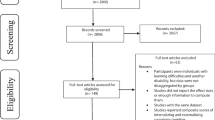Abstract
Reading, spelling, and arithmetic achievement of children treated in a day psychiatric hospital was examined over time. The results indicated that the majority of children fell in the average and above achievement group and progressed evenly over time. Almost none got worse and only a few made large gains. Organic impairment ratings appeared to distinguish the three performance groups within each subject area.
Similar content being viewed by others
References
Zimet, SG, Farley GK, Silver J, Hebert FB, Robb ED, Ekanger C and Smith D: Behavior and personality changes in emotionally disturbed children enrolled in a psychoeducational day treatment center.J Amer Acad Child Adoles Psychiat 19: 240–256, 1980.
Miller LC:School Behavior Checklist. Los Angeles: Western Psychological Services, 1977.
Jastak JF and Jastak SR:The Wide Range Achievement Test. Wilmington, DE: Guidance Associates of Delaware, 1965.
Kohn M and Rosman BL: Social-emotional, cognitive, and demographic determinants of poor school achievement: Implications for a strategy of intervention.J Educ Psychol 66: 267–276, 1974.
Money J: On learning and not learning to read. In J. Money (ed)The disabled reader. Baltimore: Johns Hopkins press, 1966.
Blom GE, Farley GK, and Ekanger C: A psychoeducational treatment program: Its characteristics and results. In GE Blom and GK Farley (eds)Report of activities of the Day Care Center of the University of Colorado Medical Center to the Commonwealth Foundation. Denver: University of Colorado Medical Center Press, 1973.
Prentice-Dunn S, Wilson, DR and Longman RD: Client factors related to outcome in a residential and day treatment program for children.J Clin Child Psychol:10 188–191, 1981.
Swan WW and Wood MM: Making decisions about treatment. In MM Wood (ed.)Developmental therapy. Baltimore: University Park Press, 1976.
Tramontana MG, Hooper SR, Curley AD and Nardolillo EM: Determinants of academic achievement in children with psychiatric disorders.J Amer Acad Child Adoles Psychiat 29: 265–268, 1990.
Jastak JF and Jastak SR:The Wide Range Achievement Test: Manual of Instructions. Wilmington, DE: Jastak Associates, Inc., 1978.
Woodward CA, Santa-Barbara J and Roberts R: Test-retest reliability on the Wide Range Achievement Test.J Clin Psychol 31: 81–84, 1975.
Covin TM and Lubinov AJ: Concurrent validity of the WRAT.Percep Motor Skills 43: 1065–1066, 1976.
Smith MK and McManis DL: Concurrent validity of the Peabody Individual Achievement Test and the Wide Range Achievement Test.Psychol Reports 41: 1279–1284, 1977.
Silverstein AR: A comparison of the 1976 and 1978 norms for the WRAT.Psychol Schools 17: 313–315, 1980.
Tramill JL, Tramill JK, Thornwaite R and Anderson F: Investigations into the relationships of the WRAT, the PIAT, the SORT and the WISC-R in low-functioning referrals.Psychol Schools 18, 149–153, 1981.
Lindquist EF (ed):Educational measurement. American Council on Education, 1963.
Wechsler D:The Wechsler Intelligence Scale for Children-Revised. New York: Psychological Corporation, 1974.
Hartlage LC and Steele CT: WISC and WISC-R correlates of academic achievement.Psychol Schools 14: 15–18, 1977.
Hollingshead AB and Redlich FC:Social class and mental illness. New York: John Wiley & Sons, 1958.
American Psychiatric Association:Diagnostic and statistical manual of mental disorders (3rd ed. rev.). Washington, DC: Author, 1987.
Winsberg BG, Bialer I, Kupietz S, Botti E and Balka EB: Home vs hospital care of children with behavior disorders: A controlled investigation.Arch Gen Psychiat 37: 413–418, 1980.
Forness SR, Bennett LB and Tosen J: Academic deficits in emotionally distrurbed children revisited.J Amer Acad Child Adoles Psychiat 22: 140–144, 1983.
Cook WW: The functions of measurement in the facilitation of learning. In EF Lindquist (ed)Educational measurement. Washington, DC: American Council on Education, 1963.
Swan WW:Final report: The Georgia Psychoeducational Program Network Research Consortium. Research Project, Field Initiated Studies, Research Projects Branch, Office of Special Education Services, U.S. Department of Education, Grant No. G08530255, 1987.
Cullinan D, Lloyd J and Epstein M:Behavior disorders of children. Englewood Cliffs, NJ: Prentice-Hall, 1981.
Huck SW, Cormier, WH and Bounds WG Jr:Reading statistics and research. New York: Harper & Row, 1974.
Baene RS, Stephens MAP, and Glenwick DS: Outcome in psychoeducational day school programs: A review.Amer J Orthopsychiat 56:263–270, 1986.
Farley, GK and Zimet SG: Can a five-minute verbal sample predict the response to day psychiatric treatment?Inter J Part Hosp 4: 189–198, 1987.
Corkey CL and Zimet SG: Relationships with family and friends in young adulthood: A follow-up of children treated in a day hospital.Inter J Part Hosp 4: 97–115, 1987.
Tramontana MG, Sherrets SD and Golden CJ: Brain dysfunction in youngsters with psychiatric disorders.Clin Neuropsychol 2: 118–123, 1980.
Tramontana MG and Sherrets SD: Brain impairment in child psychiatric disorders: Correspondencies between neuropsychological and CT scan results.J Amer Acad Child Adoles Psychiat 24: 590–596, 1985.
Author information
Authors and Affiliations
Additional information
This research was supported in part by an award from NIMH Grant No. 1 R03 MH40993-01A1 and from a grant from the Developmental Psychobiology Research Group Endowment Fund No. 1344, provided by the Grant Foundation. The authors would like to thank the staff members and children at the Day Care Center for their cooperation, and Nanci Avitable for her assistance in analyzing the data.
Rights and permissions
About this article
Cite this article
Zimet, S.G., Farley, G.K. Academic achievement of children with emotional disorders treated in a day hospital program: An outcome study. Child Psych Hum Dev 23, 183–202 (1993). https://doi.org/10.1007/BF00707149
Received:
Revised:
Accepted:
Issue Date:
DOI: https://doi.org/10.1007/BF00707149



